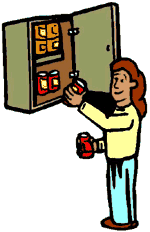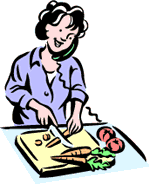Eating Cheap, Eating Well

I love to cook. I love to eat. I am picky and will not eat things that have no nutritional value (excluding chocolate, which I mentally justify for its medicinal value). I am also the type of mom who looks at recipes and instead of using them, I change them to my own liking and consider it MY personal idea.
I have the ability to open an empty cupboard and create a meal. I think I learned it from my mom through osmosis. I don't ever remember a time that I was not full and content with the meals she prepared, but thinking back, I don't have any idea how she fed 5 kids and my dad on a nurse's wage.
I got the opportunity to try out my talent when I suddenly found myself a single, pregnant mom who was only allowed $44.00 a month food stamps for myself and a three year old. I made three meals a day and snacks for us. Healthy was important, but I didn't want food to be an issue for my son either. I made sure we always had enough to eat and a little extra for fun too. (He, by the way is one heck of a cook!)

Here are some of the ways that I buy the foods I want and don't go broke doing it. These are just some of the things you could have on hand and always be able to fix a great meal and not have to run out for something special unless you wanted to.
Each meal I make has to have:
- Starch--loosely translated into potato, rice, noodles. Lean toward fresh when you can.
- Protein--red meat, chicken, fish, tofu. I find even a little in the meal means we are satisfied longer and snack less.
- Fruit--for dessert. The natural sweetness finishes the meal, not to mention most people don't eat enough of it.
- Snacks--I can't realistically leave them out. Snacking for kids is essential and it's a great way to get the fiber and extra nutrients into them.
It is cheaper and easier to buy in large packages and make meals with what you have, rather than listing ingredients and trying to buy zillions of different things. Always have on hand the following:
- All-purpose flour
- Sugar
- Onions
- Garlic (fresh is great, but I buy the jar of minced because I use it every day and it's so quick)
- Potatoes
- Baking soda
- Baking powder
- Shortening
- Vanilla
- Plain tomato sauce (generic, without seasonings)
- Condensed soups: You can go with mushroom or chicken and they are interchangeable. Try broccoli and cheese too. Please buy them in the generic brand!
And don't forget about seasonings. Here are the basics any kitchen should have:
- Salt and pepper
- Soy sauce
- Mrs.Dash
- Garlic powder (not garlic salt)
- Hot sauce (ie, Tabasco, or whatever your favorite is)
- Italian seasoning
- Cinnamon
- Onion soup mix--Buy it or make your own
- Dill

Do I have to say don't shop without a list and don't make impulse purchases?
The key to saving money and time: Buy in bulk
Buy in bulk if it is something you can freeze or keep dry in the cupboard.
The biggest money savers of all are plastic freezer bags and jars or containers that have a tight seal. Forget the little packages with just enough in them for one meal. This is a big huge money waster.
Buy preferably quart size bags and containers, and make sure they're rated freezer-safe or you'll end up with a lot of freezer-burned food. If you don't put raw meat in them, they're reusable if you wash them well and hang them to dry.
Bulk meats: Split the packages up and use those quart sized freezer bags I told you to get. When splitting up burger for freezing, see how many lbs you have in a package, then score it lightly-dividing it into 1 lb. sections before separating. You then have same size packages for freezing. DO NOT REUSE FREEZER BAGS THAT HAVE HELD RAW MEAT, not even for another package of raw meat.
Bulk noodles: Elbows and sphagetti are the biggest ones, but throw in a funky shape for fun too. I always get a box of lasagna (two, if they are on sale) and make two at the same time and freeze one uncooked and wrapped in foil. That's two nights all set to go in the same time it took to make one. Store the dry noodles in the containers and you not only have great storage but it looks cool on your counter.
Real onions in a bag: Don't buy loose and save the fancy little ones for the holidays. If you want to splurge, buy Vidalias when they are in season. You won't regret it.
Real, honest to goodness potatoes: Not in a box, foil package or bag. I know they look enticing but I bet I can recreate any kind of potato dish that you see featured on one of those packages. For the price of one box of powdered potatoes, you can buy a 10 lb. bag--enough for more meals and more options than just wall paste-type potatoes.
Beware of bulk things that are useless. A 10 lb. bag of chips looks so enticing but even I, a chipoholic, cannot stand chips for 3 weeks straight, which is how long it will take you to eat them. They aren't good after a few days anyhow. You are going to throw 8 lbs. away because they are stale.
Also be careful of huge jars of condiment. Jelly gets full of specks of "other" before you will get to the bottom of a 5-lb. jar. Pickles get cloudy before you make it through a restaurant size jar, unless you have a lot of company.
Cheap protein tips
Homemade tofu is incredibly cheap and easy to make. It is much better tasting than what you buy in the store and is much firmer. I have a recipe that makes two lbs and only uses two cups of soybeans to make! (See the Related Items list below.)
Bone-in chicken and meat is the cheapest and you can save enough over all to buy a roast or two. You can also use the bones later for stock. Right now, pork and chicken are at an all time low in my area. I am buying boneless, skinless breast of chicken for $.99/lb. I wouldn't be able to buy it for less than $3.00/lb normally.
A word on hamburger: Although it is tempting to buy the 70% lean, which is usually the cheapest, you will end up cooking so much away in fat that you have to use much more to begin with and your are throwing away money when you throw away useless grease. At the same time, the 95% is dry and so expensive that I expect it to sing and dance for the price! Stick to 80-85% and you can eye the raw amount and come pretty close to what you will end up with cooked.
Fresh veggies and fruits
Nothing makes you feel like you are eating something fancy like a salad with your meal. I do buy the premade salad in the huge bag. It says it serves 16 (again, buy generic). We eat it almost every meal and it is nice in the middle of winter to have something fresh. Maybe a head of lettuce and shredded carrot is cheaper to buy and make for myself, but I find that head lettuce is usually loose and almost hollow inside. One head makes one salad. I think of salad as our special thing to spend a little extra on (we are talking less than $3.00.) I saved more than that on the bulk hamburger!
Baby carrots are a great snack and easy to use in recipes. Buy the generic ones of these as well. Kids love to dip them and mine even ask for them as a snack! It's hard to keep a straight face and act like it's a treat for them. Try mixing peanut butter and honey for a dip if your kids are over two. Celery is a great thing for seasoning and just eating when you want something crunchy; if you put salt on it, it usually does the trick.
During the season when everything is cheap and fresh, we eat tons of great things from local stands. I try to make sure I freeze any extra or make a point to cut up some extra to freeze when I am making something. I also can vegetables and find that my family asks for home canned before any other during the winter.
Apples are always cheap. The only problem is sometimes they are soft and mealy outside of the fall. I stick to the ones that I know are crisp like Crispin and Granny Smith. Cut them up and call them a "snack" and the kids devour them.
Bananas are good snacks and can be used to thicken a shake or added to a healthy cereal to sweeten it as well as eaten on the fly.
Oranges are iffy. You can buy the bag of generic, but you take a chance on getting a bag of dry, juiceless ones. I am horrified to buy the .40 each ones because I have to get at least 6 and they won't last 48 hours! When they are on sale, I get some or just get a couple of expensive ones and cut them up right away into chunks and make a fresh fruit salad to stretch it out.
Kiwis are great. They are cheap and fun to eat. Kids love them and they have all the Vitamin C you need for the whole day in just one!
You may not know this, but melon comes frozen in bags and it is really good. The kind I get has both honeydew and cantaloupe mixed in. Great to have in the winter when the fresh ones are cost-prohibitive and usually dry inside at that.
Oh, one last thing. I keep saying buy generic, buy generic, but if the 10 lb jar of peanut butter is only 1.99? Just walk away. There is generic and there is the chemist trying to make a buck. Make sure peanut butter has actual peanuts in it and cheese has milk in it! Don't just go by the name on the label--READ the label.
Get a good basic cookbook, survey what's in your pantry, and start cooking. Don't pick recipes that require trips to the store; make a game out of staying within what's in your pantry.
Until you get the hang of it, focus on simple things--protein in a sauce over a starch, for instance. More appetizing translations: Meatballs in tomato sauce over spaghetti. Chicken and gravy over potatoes. Tofu and vegetables in a curry sauce over rice. Those kinds of dishes can be put together in no time and you can make a different one every day of the month just from the ingredients listed in the basic pantry.
Another simple example is casseroles. The universal casserole recipe is a can of condensed cream soup, cooked noodles or rice, chunked cooked protein of some kind (tuna fish, tofu, cooked chicken, ham, whatever you have), vegetables (corn, peas, carrots, potatoes), whatever seasonings you'd like (a little Spike or Mrs Dash works well in a hurry). Mix it together, throw it in a pan, top with cheese and/or something crunchy like breadcrumbs, croutons, sunflower seeds or crushed chips, and throw it in the oven. Easy! In time as you explore within the limits of your pantry you'll discover all kinds of hidden dinners.
I am notorious for not following recipes, but I still stand firmly by my Betty Crocker red checkered cookbook. There is nothing you cannot find out how to do in it. It is easy to read and get ideas from. It also has a great substitution section inside the cover for when you are half way done with a recipe and whoops! You don't have any buttermilk! I highly recommend it!
Amy Rawson is a freelance writer, and is the attachment parent leader at http://www.herplanet.com. She also runs a home-based business making homemade salves, oils and balms for babies and mamas at http://www.welcome.to/lvmyboysessentials. This article © 1999-2017 Amy Rawson. Used by permission.
